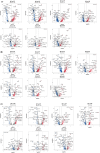Combining single-cell RNA sequencing and network pharmacology to explore the target of cangfu daotan decoction in the treatment of obese polycystic ovary syndrome from an immune perspective
- PMID: 39539629
- PMCID: PMC11557475
- DOI: 10.3389/fphar.2024.1451300
Combining single-cell RNA sequencing and network pharmacology to explore the target of cangfu daotan decoction in the treatment of obese polycystic ovary syndrome from an immune perspective
Abstract
Background: Polycystic ovary syndrome (PCOS) is a heterogeneous gynecological endocrine disorder linked to immunity. Cangfu Daotan Decoction (CFDT), a classic Chinese medicine prescription, is particularly effective in treating PCOS, specifically in patients with obesity; however, its specific mechanism remains unclear.
Methods: Part 1: Peripheral blood mononuclear cells were collected on egg retrieval day from obese and normal-weight patients with PCOS and healthy women undergoing in vitro fertilization (IVF)-embryo transfer. Next, scRNA-seq was performed to screen the key genes of bese patients with PCOS. Part 2: Active ingredients of CFDT and obesity-related PCOS targets were identified based on public databases, and the binding ability between the active ingredients and targets was analyzed. Part 3: This part was a monocentric, randomized controlled trial. The obese women with PCOS were randomized to CFDT (6 packets/day) or placebo, and the healthy women were included in the blank control group (43 cases per group). The clinical manifestations and laboratory outcomes among the three groups were compared.
Results: Based on the scRNA-seq data from Part 1, CYLD, ARPC3, CXCR4, RORA, JUN, FGL2, ZEB2, GNLY, FTL, SMAD3, IL7R, KIR2DL1, CTSD, BTG2, CCL5, HLA, RETN, CTSZ, and NCF2 were potential key genes associated with obese PCOS were identified. The proportions of T, B, and natural killer cells were higher in patients with PCOS compared to healthy women, with even higher proportions observed in obese patients with PCOS. Gene ontology and the Kyoto encyclopedia of genes and genomes analysis depicted that the differentially expressed genes were related to immune regulation pathways. Network pharmacology analysis identified that the key active components in CFDT were quercetin, carvacrol, β-sitosterol, cholesterol, and nobiletin, and TP53, AKT1, STAT3, JUN, SRC, etc. were the core targets. The core targets and their enrichment pathways overlapped with those in Part 1. Clinical trials in Part 3 found that CFDT reduced the dosage of gonadotropins use in patients with PCOS, increased the number of high-quality embryos, and improved the ongoing pregnancy rate.
Conclusion: CFDT can improve the immune microenvironment of patients to some extent, reduce their economic burden, and enhance IVF outcomes. The improvement in the immune microenvironment in obese patients with PCOS may be linked to targets such as JUN and AKT.
Keywords: cangfu daotan decoction; immune abnormalities; network pharmacology; obesity; polycystic ovary syndrome; single-cell RNA sequencing.
Copyright © 2024 Liu, Wei, Guan, Ju, Xiang and Lian.
Conflict of interest statement
The authors declare that the research was conducted in the absence of any commercial or financial relationships that could be construed as a potential conflict of interest.
Figures








References
-
- Abo-El-Yazid Z. H., Ahmed O. K., El-Tholoth M., Ali M. A. (2022). Green synthesized silver nanoparticles using Cyperus rotundus L. extract as a potential antiviral agent against infectious laryngotracheitis and infectious bronchitis viruses in chickens. Chem. Biol. Technol. Agric. 9 (1), 55. 10.1186/s40538-022-00325-z - DOI - PMC - PubMed
-
- Alam N., Banu N., Alam N. U., Ruman U., Khan Z., Ibn Aziz M. A., et al. (2022). Deciphering the pharmacological potentials of methanol extract of sterculia foetida seeds using experimental and computational approaches. Evid. Based Complement. Altern. Med. 2022, 3403086. 10.1155/2022/3403086 - DOI - PMC - PubMed
LinkOut - more resources
Full Text Sources
Research Materials
Miscellaneous

